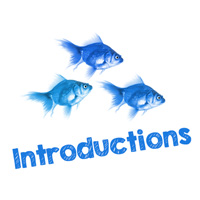
Signs That Are Close... But Not the Same — Conversation Basics
This article is part of our “Signs That Are Close... But Not the Same” series, which highlights signs that look similar, but have different meanings.
The ASL signs shown below look similar, but are not the same. There are many ASL signs that when produced look similar, but in fact have a completely different meaning. Below you will find examples of such signs. Watch closely to see if you can see the differences. In addition, watch my eyebrows, look to see when I tilt my head or lean my body in a certain way, even what my mouth is doing. These nuances are called inflections and trust me, inflections matter.
These examples are all signs used when beginning to sign and having conversations.
1. Please vs. Sorry
PLEASE and SORRY both have the dominant hand making a circular motion on the chest. PLEASE uses an open B handshape and SORRY uses an A handshape.
 |
2. Please vs. Enjoy
Both PLEASE and ENJOY have the dominant open flat hand make a circle over the chest; ENJOY also has the non-dominant hand circling over the stomach at the same time. To remember PLEASE, think of when something is pleasing it warms your heart. Think of all the different kinds of food you enjoy to help remember ENJOY also circles over the stomach.
 |
3. Understand vs. Don't Understand
UNDERSTAND and DON’T UNDERSTAND are signed the same, with the exception of the head shaking no and the negative facial expression. This is a great example of how important non-manual signals are to the meaning of signs!
 |
4. Know vs. Don't Know
While KNOW has the dominant open B handshape tap the side of the forehead (where knowledge is kept), DON’T KNOW has the dominant open B handshape touch the side of the head and then turn the palm out and push that knowledge out of the head.
 |
5. Different Ways to Sign Help
When signing HELP (as in, "to help or assist") the dominant 10 handshape resting on the non-dominant B handshape starts at waist level and is pulled up.
 |
However, HELP is a directional sign. Directional signs are signs that describe both the action and who performed the action. By changing the directionality of the sign, the meaning is changed. So when you are describing who helped whom, you change the direction of the sign.
- When signing HELP (as in, "someone helping me") the sign starts away from the body and moves toward the body. The motion of starting away and moving in toward the body, or toward “me,” represents that someone is helping me (the signer).
- When signing HELP (as in, "you helping someone") the sign starts close to the body and moves out, away from the body. This motion represents me (the signer) helping someone else.
- When signing HELP (as in, "someone helping someone else") the signs starts in one area (usually one side of the body) and moves to another area (usually the other side of the body). This is typically when you are having a conversation and have described one person using one area of signing space and another person in another area of signing space. The sign HELP then moves from the area you set up for the person that helped to the second area you set up for the person who received the help.
 |
6. Friend vs. Good Friend
Both FRIEND and GOOD FRIEND use the connected X handshapes to represent entwined lives of friends. FRIEND has the X handshapes connect together, pull apart and flip, then connect again. GOOD FRIEND has the connected X handshapes move forward together. The pull is strong because they are such GOOD FRIENDS.
 |
7. Learn vs. Student
LEARN and STUDENT look similar because they both include the sign for LEARN. However, STUDENT is a compound sign merging LEARN + the PERSON AGENT. The PERSON AGENT is a sign used in combination with different signs to mean an occupation or a person who does that action.
 |
8. Teach vs. Teacher
Like LEARN and STUDENT, TEACH and TEACHER look similar because they both include the sign for TEACH. However, TEACHER is a compound sign merging TEACH + the PERSON AGENT.
 |
How can I figure out the difference between signs on my own?
If you see two signs that look close, but not the same, and you’re not sure, you may use Signing Savvy features to help you figure out the difference. All of our signs have sign descriptions and memory aids that members may access. Reading the sign description and memory aids for the signs will help you figure out the small differences between them that your eyes don’t catch at first. We also recommend using the pause and slow motion feature to slow down the video, so you may take a closer look. These features are available to Signing Savvy members.
ADVERTISEMENTS
 Brenda Cartwright is a Coda, seasoned interpreter, a master teacher, well known presenter, and author of several best selling sign language and interpreting textbooks from the RID Press. For 35 years Brenda was the Chair of the Sign Language Interpreter Program at Lansing Community College in Lansing, Michigan.
Brenda Cartwright is a Coda, seasoned interpreter, a master teacher, well known presenter, and author of several best selling sign language and interpreting textbooks from the RID Press. For 35 years Brenda was the Chair of the Sign Language Interpreter Program at Lansing Community College in Lansing, Michigan. Signs That Are Close... But Not the Same — Introductions
Signs That Are Close... But Not the Same — Introductions Name Signs: What Are They and How Does a Person Get a Name Sign?
Name Signs: What Are They and How Does a Person Get a Name Sign? Signs That Are Close... But Not the Same — Calendar Signs
Signs That Are Close... But Not the Same — Calendar Signs






